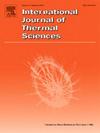废玻璃粉尘增强天然纤维复合材料的传热分析:数值与实验研究
IF 4.9
2区 工程技术
Q1 ENGINEERING, MECHANICAL
International Journal of Thermal Sciences
Pub Date : 2025-04-11
DOI:10.1016/j.ijthermalsci.2025.109925
引用次数: 0
摘要
由于对成本效益高、重量轻的隔热材料的需求不断增加,因此有必要利用工业和生物废料中的聚合物来开发此类材料。对其热性能的评估也同样重要。有鉴于此,本研究报告利用废玻璃粉尘(WGD)作为聚合物复合材料的功能填料,并用麻和亚麻两种不同的天然纤维进行增强,从而开发出一种新型隔热材料。该研究开发了一种独特的一维热传导模型,利用基于有限元法的工具和适当的边界条件对此类复合材料的 Keff 进行数值估算。然后,采用手糊工艺制造出不同填料浓度(0%-20%(重量百分比))的麻-环氧和亚麻-环氧复合材料。测量了所制复合材料的热性能,如传导率、热膨胀系数(CTE)和玻璃化转变温度(Tg)。结果发现,数值模型和实验结果在传导性方面非常吻合。研究还发现,通过添加天然纤维和废玻璃粉,环氧树脂的 Keff 可以降低到 0.144 W/m.K,约为 25%。同样,CTE 值(27.238 × 10-6/°C)最大可降低约 34%。加入玻璃微尘颗粒后,大麻-环氧树脂和亚麻-环氧树脂复合材料的 Tg 分别从 97 ℃(环氧树脂)提高到 125.43 ℃ 和 127.03 ℃。这些复合材料具有较低的传导性、良好的热膨胀系数(CTE)和热导率(Tg),可用于隔热应用。本文章由计算机程序翻译,如有差异,请以英文原文为准。

Heat transfer analysis of natural fiber composites reinforced with waste glass dust: a numerical and experimental study
Rising demand for cost effective and light weight thermal insulation, necessitates to use industrial and bio-wastes in polymers to develop such materials. The estimation of their thermal properties are also equally pertinent. In view of this, the present work reports on the utilization of waste glass dust (WGD) as functional fillers in polymer composites reinforced with two different natural fibers like hemp and flax to develope a new class of thermal insulation. A unique one dimensional heat conduction model is developed to numerically estimate the keff of such composites using a finite element method based tool with suitable boundary conditions. Sets of hemp-epoxy and flax-epoxy composites of different filler concentrations (0 %–20 % by weight) are then fabricated using hand lay-up route. Thermal properties such as conductivity, coefficient of thermal expansion (CTE) and glass transition temperature (Tg) of the fabricated composites are measured. The numerical model and experimental results in regard to the conductivity are found to be in good agreement. It is also found that the keff of epoxy can be reduced up to 0.144 W/m.K, about 25 % by the reinforcement of natural fibers and waste glass dust. Similarly, a maximum reduction of about 34 % in the value of CTE (27.238 × 10−6/°C) is achieved. Tg is found to improve from 97 °C (epoxy) to 125.43 °C and 127.03 °C for hemp-epoxy and flax-epoxy composites respectively with the addition of the glass dust particles. Armed with reduced conductivity and favourable CTE and Tg, these composites can potentially be used in thermal insulation applications.
求助全文
通过发布文献求助,成功后即可免费获取论文全文。
去求助
来源期刊

International Journal of Thermal Sciences
工程技术-工程:机械
CiteScore
8.10
自引率
11.10%
发文量
531
审稿时长
55 days
期刊介绍:
The International Journal of Thermal Sciences is a journal devoted to the publication of fundamental studies on the physics of transfer processes in general, with an emphasis on thermal aspects and also applied research on various processes, energy systems and the environment. Articles are published in English and French, and are subject to peer review.
The fundamental subjects considered within the scope of the journal are:
* Heat and relevant mass transfer at all scales (nano, micro and macro) and in all types of material (heterogeneous, composites, biological,...) and fluid flow
* Forced, natural or mixed convection in reactive or non-reactive media
* Single or multi–phase fluid flow with or without phase change
* Near–and far–field radiative heat transfer
* Combined modes of heat transfer in complex systems (for example, plasmas, biological, geological,...)
* Multiscale modelling
The applied research topics include:
* Heat exchangers, heat pipes, cooling processes
* Transport phenomena taking place in industrial processes (chemical, food and agricultural, metallurgical, space and aeronautical, automobile industries)
* Nano–and micro–technology for energy, space, biosystems and devices
* Heat transport analysis in advanced systems
* Impact of energy–related processes on environment, and emerging energy systems
The study of thermophysical properties of materials and fluids, thermal measurement techniques, inverse methods, and the developments of experimental methods are within the scope of the International Journal of Thermal Sciences which also covers the modelling, and numerical methods applied to thermal transfer.
 求助内容:
求助内容: 应助结果提醒方式:
应助结果提醒方式:


